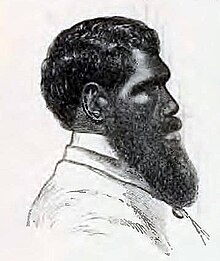Wonga, the principal man of the Yarra tribe, and his wife—are two well-known natives. Wonga has a mild disposition, and is always gentle and courteous. He is a good speaker, and has much influence with his people. The man to the right of the central figure is Nathaniel, generally regarded as highly intelligent. He was educated at the Lake Hindmarsh Station. The man holding a spear is Whyate, a black from the western coast. He is of a type that is by no means common. The central figure shows a native in ordinary attire.
 |
| FIG. 3. |
The likeness in profile (Fig. 3) is that of a full-blooded black of the ordinary type. The form and expression are strongly characteristic of the natives of the south. The portrait of a woman (Fig. 4) shows the more marked features that are commonly found amongst the females of the Yarra. These portraits exhibit with sufficient distinctness the general character of the features of the natives of Victoria. The eyebrows are broad and prominent, over-hanging deep-set and not very small eyes; the head narrows rapidly towards the vertex; the mouth is large, and arched, as if the corners were purposely drawn down; the lips are full. The under-jaw of the males is, in many instances, massive and square; in others, owing to the size and shape of the mouth and teeth, it is retreating. The nose is depressed at the upper part, and wide at the base, and in some the wings are elevated; the space between the nose and the mouth is great, and the alveolar process is much developed. The cheek-bones are high. The teeth are large and regular, and when set, meet closely, the cusps being usually worn off, owing to their modes of cookery and feeding. In many the neck is short and pretty thick, but thin necks are not uncommon.
 |
| FIG. 4. |
When in repose, the expression of the countenance is not pleasing. It is rather sullen than melancholy. But when anything occurs to arouse the curiosity of the native, his face lights up at once, and the sour, morose expression gives place to one that is far from disagreeable. He can indicate by his features discontent, dislike, hatred, affection, satisfaction, curiosity, and appreciation of humour, with unmistakable effect. In like manner he can show by his gait and his gestures fear, respect, obedience, courage, defiance, and contempt. Those who have lived long amongst the natives and are acquainted with their habits are not readier than those who see them for the first time in comprehending what is expressed by their attitudes.
